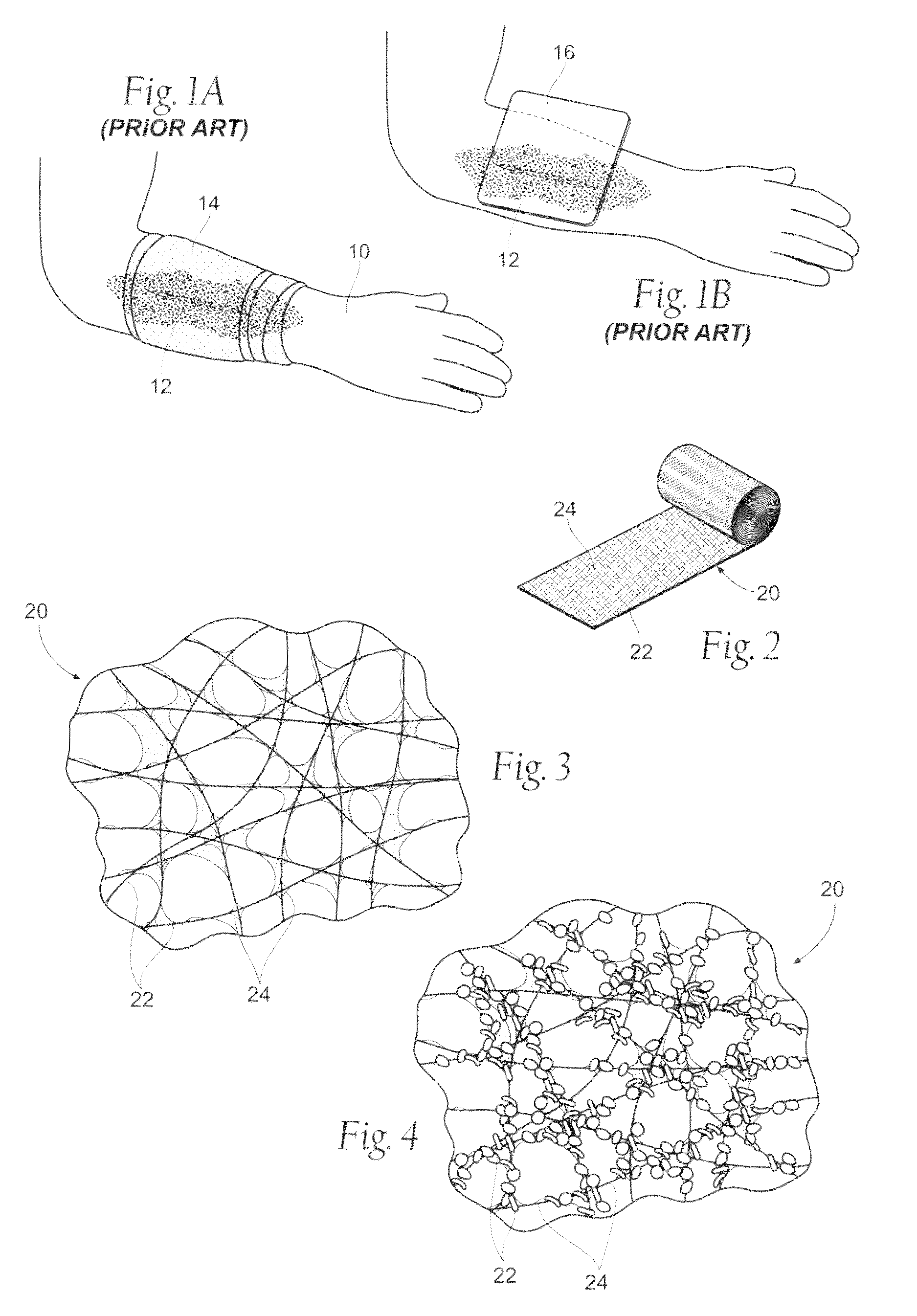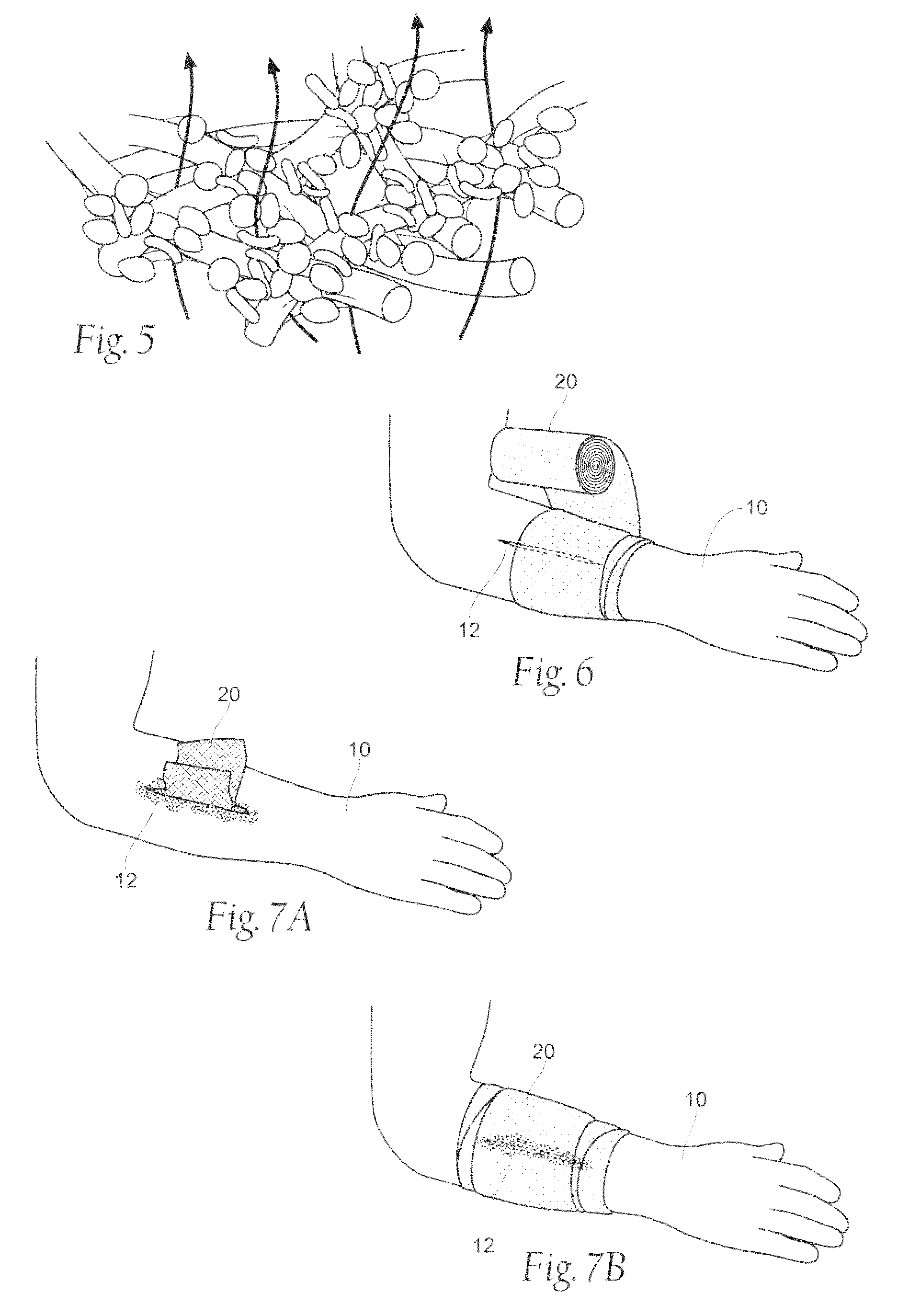Wound dressing devices and methods
a wound dressing and flexible technology, applied in the direction of bandages, biocide, drug compositions, etc., can solve the problems of increasing the cost of wound dressings, etc., to achieve sufficient stiffness, stabilize bleeding, and stabilize bleeding
- Summary
- Abstract
- Description
- Claims
- Application Information
AI Technical Summary
Benefits of technology
Problems solved by technology
Method used
Image
Examples
example 1
[0091]A cotton gauze (i.e. carrier strip 22) was soaked in 1% chitosan and 2% acetic acid solution (chitosan material 24) for 12 hours. The gauze was stirred dry in an oven at 50° C. for 24 hours. The dry gauze (i.e. the wound dressing assembly 20) was then rolled and packaged in a heat-sealable pouch. The package was sterilized using gamma irradiation. The wound dressing assembly 20 had a moisture content of 1.58±0.44%, with the residual volatile acid content ranging from between 1 to 3.5%.
example 2
[0092]A cotton-made gauze (i.e. carrier strip 22) was soaked in 1% chitosan and 2% acetic acid solution (chitosan material 24) for 12 hours. A chitosan powder (26) pretreated with acetic was coated on the gauze. The chitosan powder had a particle size of between 200 to 400 mesh and emitted zero or near zero volatile organic compounds. The excess powder was removed from the gauze, and the gauze was dried in an oven at 50° C. for approximately 24 hours. The dry gauze (i.e. the wound dressing assembly 20) was then rolled and packaged in a heat-sealable pouch. The package was sterilized using gamma irradiation.
[0093]The resultant wound dressing assembly 20 is capable of stanching the flow of blood and other bodily fluids at a wound site, as shown and described above with respect to FIGS. 2-7B. The improved absorbency and efficacy of the wound dressing is further described and discussed in the following section that described the physical properties of the dressing assembly.
C. Physical P...
example 3
[0123]A wound dressing assembly as prepared according to Example 1, above was tested to determine its ability to control hemorrhaging. An auxillosubclavian injury was created in a porcine model. The injury was created with a 2-cm skin entry and was approximately 10-cm deep from the skin to the axillary artery. The axillary artery was trimmed to 3 cm length and dilated with vasodilator (1% lidocaine / paravine solution, having a 4:1 v / v ratio). A 4-mm diameter perforation injury was created in front of the axillary artery using a 4 mm vascular punch, from Ethicon, in N.J. The wound dressing was applied through the 2-cm entry to fill and pack in the wound under manual pressure for 3 minutes. After pressure was released the hemorrhaging from the wound was controlled.
[0124]FIG. 27 provides further comparison and results of dressing assemblies of the present invention compared to similar prior art dressing assemblies, i.e. control assemblies. FIGS. 28-43 provide various SEM images of the d...
PUM
| Property | Measurement | Unit |
|---|---|---|
| diameter | aaaaa | aaaaa |
| pressure | aaaaa | aaaaa |
| volume | aaaaa | aaaaa |
Abstract
Description
Claims
Application Information
 Login to View More
Login to View More - R&D
- Intellectual Property
- Life Sciences
- Materials
- Tech Scout
- Unparalleled Data Quality
- Higher Quality Content
- 60% Fewer Hallucinations
Browse by: Latest US Patents, China's latest patents, Technical Efficacy Thesaurus, Application Domain, Technology Topic, Popular Technical Reports.
© 2025 PatSnap. All rights reserved.Legal|Privacy policy|Modern Slavery Act Transparency Statement|Sitemap|About US| Contact US: help@patsnap.com



